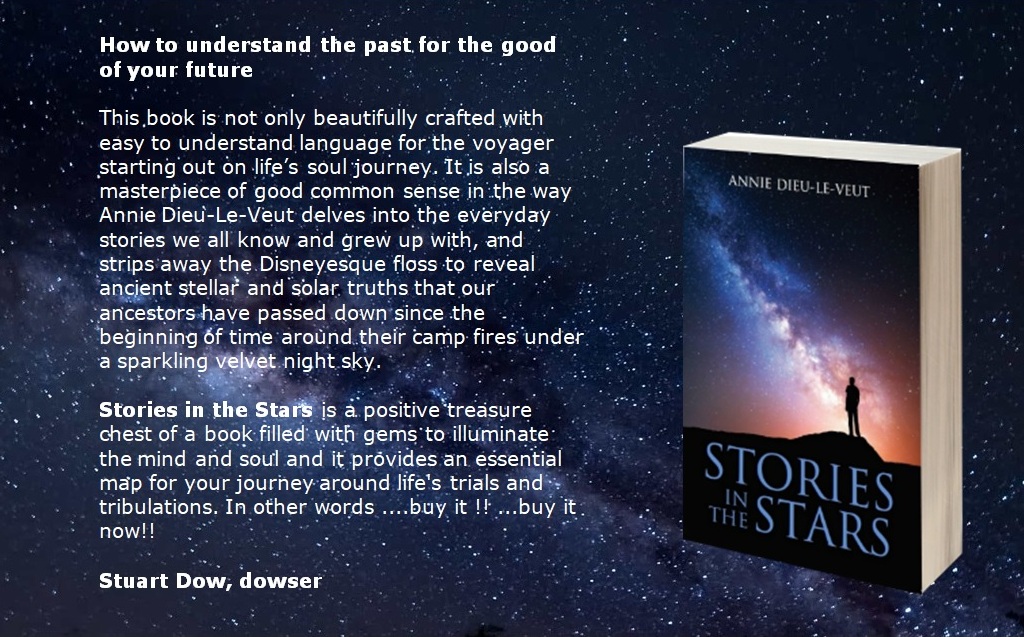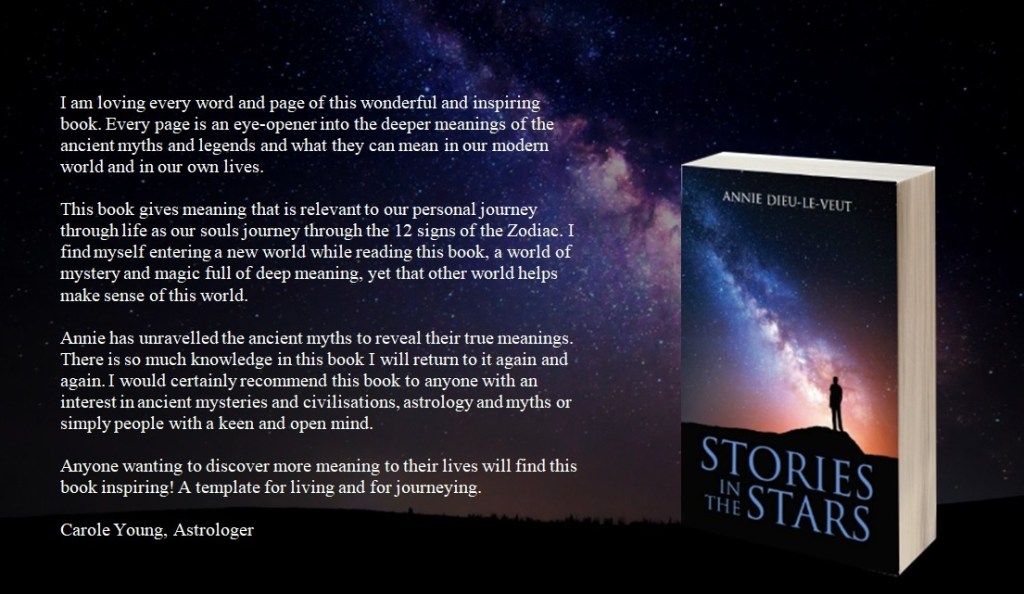Stories in the Stars: What our ancestors were trying to tell us explores how ancient myths are actually the vessels or arks of our ancestors sailing the seas of Time and containing, deep in their submarinal holds, precious messages about our innate holographic relationship to eternal astrological and alchemical cycles which drive each of us along our life’s path.
Over thousands of years, these orally-transmitted wisdom teaching stories have been twisted and bastardised into fake histories in order to serve various and changing political imperatives. And they have been concertinaed, truncated and dumbed-down to satisfy the appetites of light entertainment through the shifting narratives, over time, of the mytho-industrial complex.
I am a story archaeologist – someone who digs up the originals of these epic tales that were drawn in the glittering night skies of the last Ice Age. I brush them off and then break down their meanings in the simplest of terms, so that we can unlock the doors of our perception with their metaphorical keys.
Stories in the Stars explains all this and there are many practical exercises for the reader to learn how to apply this way of thinking to their own life’s journey and so after reading it, you should be better able to expertly steer your human vessel.
The only difference between mythology and history is that myths are true
IT IS often said that history is written by the victors; that after a military campaign has been won, the information war begins when the court scribes and hagiographers of a mytho-industrial complex are appointed to provide written content designed to provide a narrative with the aim of winning the hearts and minds of the people who have just been conquered.
Humanity has been ruled in this way for thousands of years, the only difference nowadays being that what our descendants will come to call “history” is currently being written in live time by digital propagandists who broadcast their narrative throughout the internet, mainstream media and the silver screen.
So much of received history could be described as a tissue of lies or, at least, propaganda and spin, as the myths of the indigenous peoples are often plundered and twisted to provide the storylines when a new historical “backstory” is required for a nation. For instance, after the Norman conquest of Britain in the 11th century, Geoffrey de Monmouth wrote Historia regum Britanniae (The History of the Kings of Britain), which he based on ancient myths. However, his book was no history, because those Arthurian legends were not about characters that had actually lived or events that really happened; they were metaphors for alchemico-cosmological truths that are, in themselves, eternal and in that way have veracity as guides and blueprints to help us thrive and evolve today.
Hence, the only difference between mythology and history is that myths are true, so long as they are excavated properly and – just as importantly – interpreted correctly, by those who have the eyes to see, because they were composed by people who thought very differently to how we do today. And so this is where I come in with this book.
I’m a shaman and also a sort of story archaeologist. I have a mental image of myself, digging and digging and digging underneath all the rotting story mats of the wandering troubadors and tale-tellers of old in an attempt to find the original story. Some of those story mats have become quite ragged by now; others have gone decidedly mouldy.
However, the deeper I dig, the closer to the primary story I get.
Most of the ancient myths that have survived and are available to us today were translated either by Christian monks or by PhD scholars. As far as I know, none of them were transcribed by shamans, which is crucial because our forebears, who composed these stories, had a much more shamanic mindset than we may realise. So I view these old sagas from antiquity through a more multi-dimensional lens and thus find the themes running through them are based upon a cosmologically-conceived wisdom that has almost vanished from awareness today. I then weave these myths into my own stories in a way that I think better reflects their true, original nature, so that they can be of help to us today in the same way that they acted as psychological Sat Navs for aiding the ancients to make sense of their lives.
It is not too late. We can recover the mytho-poetic vision that was key to how our ancestors saw themselves as an integral part of the forces that generate and regenerate life on Earth, which they experienced and honoured in sacred rites and shamanic journeying. So this latest book, Stories in the Stars: What our ancestors were trying to tell us, is organised to provide a smooth and simple, stepped upward journey in laying out this philosophy in which each teaching is based upon the one behind it.
We begin at the end of the last major Ice Age, and the stories told by our nomadic ancestors around their camp fires that were, so to speak, written in the stars. In other words, they would draw out their characters, dot-to-dot, in sparkling lines across the pitch-black skies and then compose and recount stories about them. But you may not know who they really were and why they actually did this. You may still believe that they were grunting, monosyllabic, club-dragging caveman incapable of intelligent thought – and with a standard Western education, you could hardly be blamed for that.
So in Part 1: Into the Deluge, I make the case for their advanced astronomical-astrological wisdom and technology that was holographically connected to their spiritual wisdom and profound understanding about the value and purpose of human life before going on to their earliest star stories – the deluge myths – that follow the challenges and travails of the courageous hero who erects each of the new pole stars as they precess from age to age.
In Part 2: The Language of the Initiates, we stop to examine some of the common symbols and metaphors used in these ancient myths to uncover their hidden astrological and alchemical significance, and then we learn how to apply them to our spiritual progress today, before going on to…
Part 3: Into the Zodiac, in which we will analyse slightly later myths, through the lens of our new understanding about their meaning, that developed from the agricultural revolution onwards and that featured the zodiac hero of the 12 Sun signs.
A note for women
You may wonder why the hero in so many ancient stories is a male and not a female, and you might find it annoying that I continually use the pronoun “he” rather than “he or she” throughout Stories in the Stars. Please allow me to explain.
Largely speaking, I didn’t want to use “he or she” because it smacks too much to me of political correctness in this present time, with the women’s movement purporting to fight “the tyranny of the patriarchy”.
I don’t subscribe to that view. In fact, to me, the idea that the male of the species unfairly dominates the female is a complete canard, although these particular ladies are quite correct in that we do not have equality with men.
The way I see it, women for millennia have dominated and controlled men in the most subtle of ways and it is to those feminine arts, passed on from mother to daughter, that I attribute the success of the human race as a species. Otherwise, how could it be that a gender which is innately polygamous when going through its late adolescence and early adulthood evolves so quickly into settling down quietly with one woman, to help her raise a family?
In ancient times, the grandmothers were the shamanic storytellers and the singers over the cradle who developed myths featuring a male hero who journeyed through the stars as vehicles or “arks” in which to convey, to their charges, the secret keys that seed the wisdom needed to climb the alchemical ladder of life in order to develop successfully into full manhood. Those sagas (so named after the keeper of the ancestral memory Sága of the Norse Eddas, meaning “great grandmother”) eventually became part of a series of what were known as Mystery teachings, and young men would learn them during rites of passage retreats, away from the village.
These same “arks” have now come down to us, floating on our Rivers of Blood (our DNA or “race memory”) and thus they still create the narrative that has underpinned our mores and laws for countless thousands of years that are responsible for the success and good fortune of the human race. Conversely, when this narrative is turned on its head, it leads to a reversal of fortune.
This stellar-based blueprint is based upon the notion of hierarchy; the original Greek meaning of the word being “spiritual rule”. So these most ancient of tales are designed to impregnate the cosmological understanding in the subconscious about the universal governance to which the individual must submit in order for their heriditary line to thrive and survive.
But what does that mean for us today?
For the male, spiritual initiations have always had to be more formally structured through rites-of-passage retreats and ceremonies. This is because, unlike the women, men do not naturally receive their initiations as a matter of course from the Moon at the first period, and then again at the time of giving birth and finally, at the menopause. This is one of the allegorical meanings behind the symbol of three-faced goddess of the maiden, the mother and the crone.
Having said all that, women also benefit from the story of the mythological hero, partly because it helps them develop their male side and partly because literature that is designed to help the man to better understand himself also informs women in that it helps them improve their relationships with the male of the species. Finally, women need to fully comprehend ancient myths in order to be able to educate their own children properly.
And so in learning about the wisdom buried in these Stories in the Stars about the archetypal champion, both men and women will end up discovering a deeply-rooted alchemical map for their own lives and thus will develop a more metaphorical, cosmological view and a growing feel for eternal truths that helps to make sense of our own existence.
Stories in the Stars is available from Amazon UK, Amazon US and all good online book stores.
Reviews







